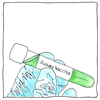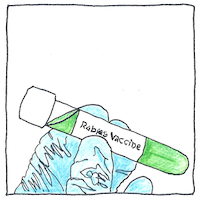Pierre Paul Émile Roux,
Louis Pasteur
immunology

|
Rabies vaccine
Émile Roux took the nerve tissue of rabbits that had died of rabies and let it dry. Émile Roux was a research assistant for Louis Pasteur. Even though they were not able to identify the pathogen the idea was to inactivate the virus and use that as a vaccine against the disease. And Joseph Meister, nine years old, was bitten badly by a rabid dog. The vaccine was not tested and Louis Pasteur was not licensed to practice medicine but he did what he could. He saved the boy’s life.
Behavior modification
The rabies virus replicates in the muscle and enters the central nervous system to travel to the brain. From the brain, it migrates to the salivary glands ready to infect its next victim. In the brain, it makes its host more aggressive and likely to bite to facilitate its own transmission.
Joseph Meister reflects
Clearly, I would have died a painful death. Who cares what complications waited for me? Death of old age? An aversion to Nazis? Fear that I had sent my loved ones to their deaths?



Unlike smallpox, rabies has not been eradicated, although there are efforts to immunize wild populations that carry the virus. Each year, use of the vaccine continues to save more than a quarter million lives.
See also in The book of science:
Readings in wikipedia: